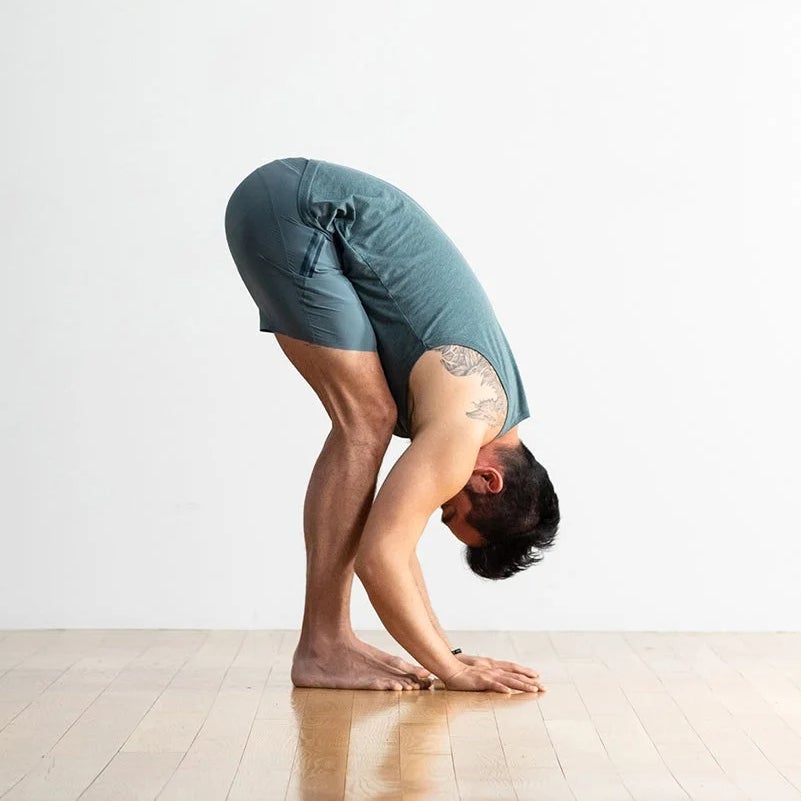Got lower back pain? Join the club. According to the National Institutes of Health, will experience lower back pain at some point during their lives. But just because it’s common doesn’t mean that it’s something you have to live with. Your lower back is designed to stabilize and support your every movement. When it’s out of whack, not only does your back feel awful, but it mental health can be impacted, as well. The good news is that can help you find some sweet, sweet relief.
What Actually Hurts When You Have Lower Back Pain?
Your lower back consists of the five lumbar vertebrae at the bottom of your spine (L1 to L5). The lumbar vertebrae are the largest when compared to the rest of your spine and help support your upper and lower body, allow you to twist and move your torso, and protect your spinal cord. There is also a complex network of ligaments, muscles, and tendons here to help everything move properly and stay in place.
The lumbar region handles high stress and heavy loads when you’re walking, running, lifting, carrying, or doing just about anything—which is why it’s no surprise that lower back pain is so common.
There are a few issues that can cause lower back pain. A bulging disk happens when the cushioning between your vertebrae gets compressed and can’t do its job properly. Herniated disks can cause pinched nerves. But often, lower back pain is a symptom of a strain or tear that occurred as a result of weakened muscles.
What Causes Lower Back Pain?
���ϳԹ��� of the more common medical reasons, such as a bulging disk or osteoarthritis, a major cause of lower back pain is prolonged sitting or standing (yes, we’re looking at all of you working from home!). The more you sit, the less you use your stabilizing muscles, causing them to weaken and have difficulty doing their job when you need them, leading to pulled/strained or sprained muscles (and lots of pain).
When your muscles are weak, the simplest actions can cause lower back pain: picking up your child, carrying something heavy, or twisting the wrong way in the car.
These yoga poses help relax tight muscles, strengthen weak muscles, and . But remember—take your time getting into each pose, and if something hurts at any point, stop! Adapt your practice to how your body feels in each moment, and be gentle with yourself to ensure you don’t make your back pain worse.
8 Poses to Relieve Lower Back Pain
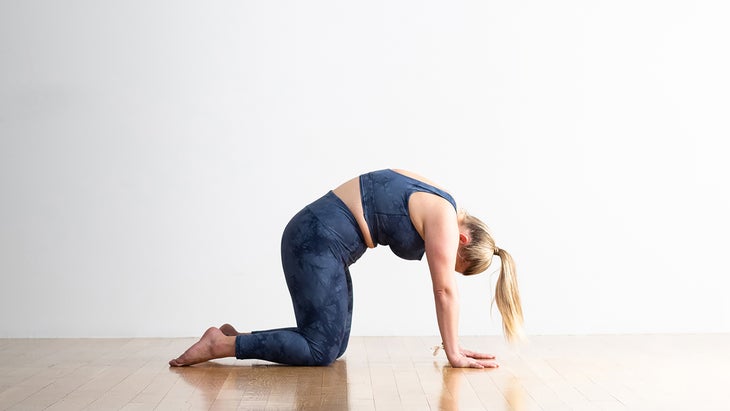
1. / (Cat-Cow Pose)
Cat-Cow is a great way to stretch your hips, chest, and back during your warm-up.
Start on your hands and knees in Tabletop position. Make sure your knees are set directly below your hips and your wrists, elbows, and shoulders are in line and perpendicular to the floor. Center your head in a neutral position, eyes looking at the floor.
As you inhale, lift your sitting bones and chest toward the ceiling, allowing your belly to sink toward the floor. Lift your head to look straight forward. As you exhale, round your spine toward the ceiling, making sure to keep your shoulders and knees in position. Release your head toward the floor, but don’t force your chin to your chest.
Repeat as many times as needed (10–20 inhales and exhales is a good number), following the pace of your breath.
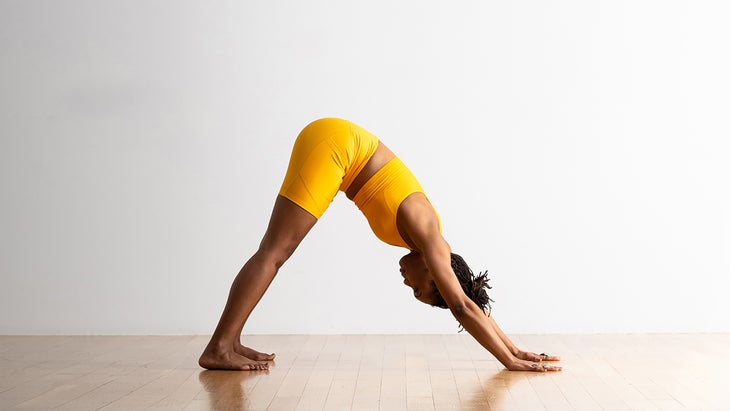
2.
If there is one that most everyone knows, it’s probably Downward-Facing Dog Pose. Offering lengthening and strengthening, this one can hit all the tight spots to loosen up your shoulders, back, hamstrings, and more.
Start on your hands and knees in Tabletop. Curl your toes under, press into your shoulders, and lift your hips up and back.
Press down firmly with your fingertips and palms to pull your forearms toward the front of the room. Roll your inner upper arms toward the wall in front of you while engaging your outer upper arms. Engage your shoulders, allowing your shoulder blades to spin out and up, away from your spine and toward your outer armpits (upward rotation).
If your lower back feels rounded, bend your knees slightly so that you can lift your hips higher. You want a straight line from your wrists to your shoulders to your hips—don’t worry about straightening your legs!
Glance back at your feet to make sure they are hip-width apart and parallel. Finally, let your head hang freely so there is no tension in the neck and gently gaze toward your feet. Hold for a few breaths and then release back to Tabletop or to Child’s Pose.
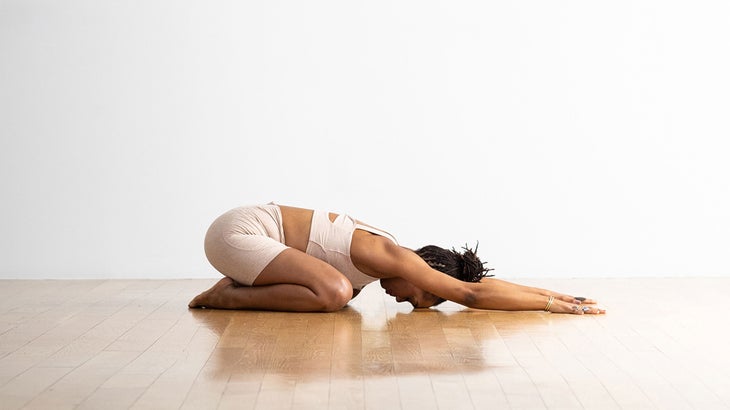
3.
Child’s Pose is not only a resting or calming pose, but it also provides a great stretch for your back and hips.
Kneel on the floor. Touch your big toes together and sit on your heels, then separate your knees about as wide as your hips. Exhale and lay your torso down between your thighs.
Broaden your sacrum across the back of your pelvis and narrow your hip points toward the navel, so that they nestle down onto the inner thighs. Lengthen your tailbone away from the back of the pelvis while you lift the base of your skull away from the back of your neck. Rest your forehead on the mat.
Stretch your arms forward with your palms down and fingers spread wide. Rest here for anywhere from a few breaths to a few minutes.

4.
This may seem like a very basic pose, but don’t be fooled—Standing Forward Bend stretches and releases your hamstrings, calves, and hips; strengthens your quadriceps; and relieves stress.
Stand straight up in , hands on your hips. Exhale and bend forward at your hips, not your waist, to lengthen the front torso.
If possible, with your knees straight, bring your palms or fingertips to the floor slightly in front of or beside your feet, or bring your palms to the backs of your ankles. If this isn’t possible, cross your forearms and hold your elbows. Press the heels firmly into the floor and lift the sitting bones toward the ceiling. Turn the top thighs slightly inward.
With each inhale, lift your body slightly. With each exhale, release into the pose a little more. Let your head hang from the root of the neck, which is deep in the upper back, between the shoulder blades.
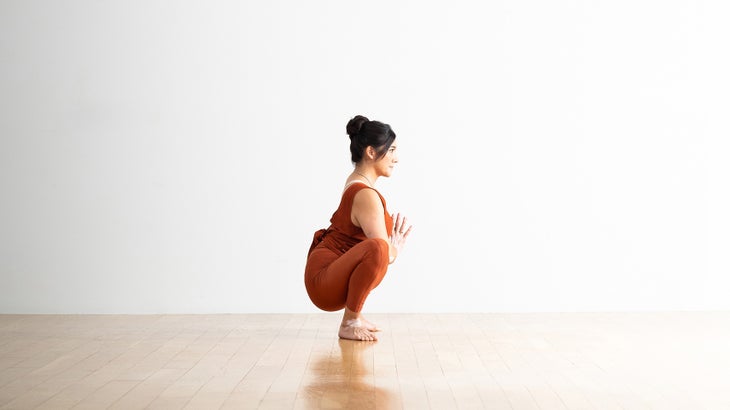
5.
Garland Pose stretches just about everything around your lower back—quadriceps, groin, hips, and torso—as well as strengthens your ankles.
Squat with your feet as close together as possible. Keep your heels grounded on the floor if you can. If not, roll up your mat or put a towel under them. Separate your thighs slightly wider than your torso. Exhaling, lean your torso forward and fit it snugly between your thighs.
Press your elbows against your inner knees, bringing your palms to together in , and resist the knees into the elbows to help lengthen your front torso. Hold for 30–60 seconds.
6.
This gentle backbend is great for beginners or as a warm-up at the beginning of your practice to stretch your chest, shoulders, and abdomen while strengthening your back.
Lie on your belly, legs side by side. Firm your tailbone toward your pubis and lengthen it toward your heels. Then, rotate your thighs inwardly by rolling your outer thighs toward the floor. This helps broaden and lengthen your lower back and sacrum (the downward-facing triangular bone at the back of your pelvis) to protect it in a backbend. Continue lengthening as you move into this pose to protect your lower back and be sure to engage your buttocks.
Set your elbows under your shoulders and your forearms on the floor parallel to each other. Inhale and lift your upper torso and head away from the floor into a mild backbend. Very subtly—no sucking in, hardening, or rigidity— draw your lower belly away from the floor to support and distribute the curvature of your backbend more evenly along the length of the spine, soothing your lower back. Stay for 5–10 breaths and then lower your torso to the floor. Repeat if you’d like.
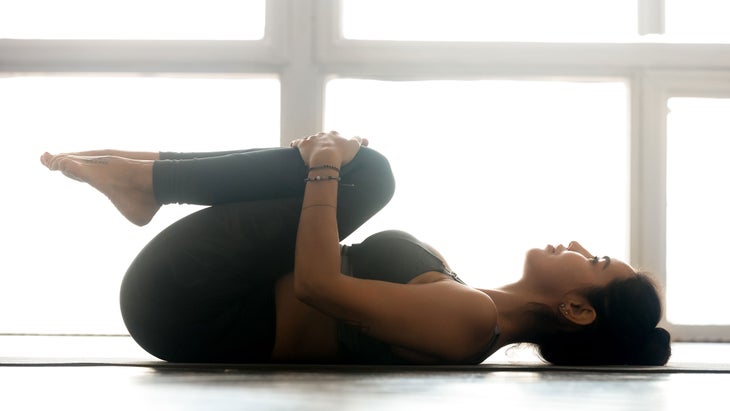
7. Apanasana (Wind-Relieving or Knees-to-Chest Pose)
The primary benefit of Knees-to-Chest Pose is that it stretches and relaxes your lower back, which can reduce lower back pain.
Lie fully extended on your back. Bend your knees and lift your feet off the floor one at a time, bringing your knees as close to your chest as possible. Use both hands to hold your shins or thighs as you hug your knees to your chest. Rock gently from side-to-side to give your lower back a massage. Stay here for as long as you’d like, then release back to the fully reclined position.

8. Supta Matsyendrasana (Supine Spinal Twist)
Twisting can irritate your lower back, so if you feel any pain in this one, skip it. That being said, the Supine Spinal Twist stretches your glutes and back muscles while lengthening and relaxing your spine, which is great for relieving a tight or sore lower back.
Lie fully extended on your back and make a T with your arms out to the sides at shoulder level. Bend your knees and inhale as you lift your feet off the floor, bringing your knees directly over your hips to create a right angle with your legs. Exhale and let your knees fall to your right. Keep your shoulders on the mat. Your left hip will lift as you twist to the right. Hold for 1–2 minutes. Bring your legs back to center and switch sides.


